Smart devices are no longer limited to phones and laptops. These days, everything from your fridge to your fitness tracker can connect to the internet.
That’s what the Internet of Things is all about—ordinary objects becoming smarter by being able to send, receive, or act on data.
Whether it’s a factory sensor alerting staff to a problem or a smart home system adjusting your lights automatically, IoT is changing how we live and work. And it’s growing fast.
Statista reports that billions of IoT devices are already in use, with even more coming as technology improves and more industries get on board.
The following IoT stats will dive deeper into the IoT space as interest and investment start to really pick up.
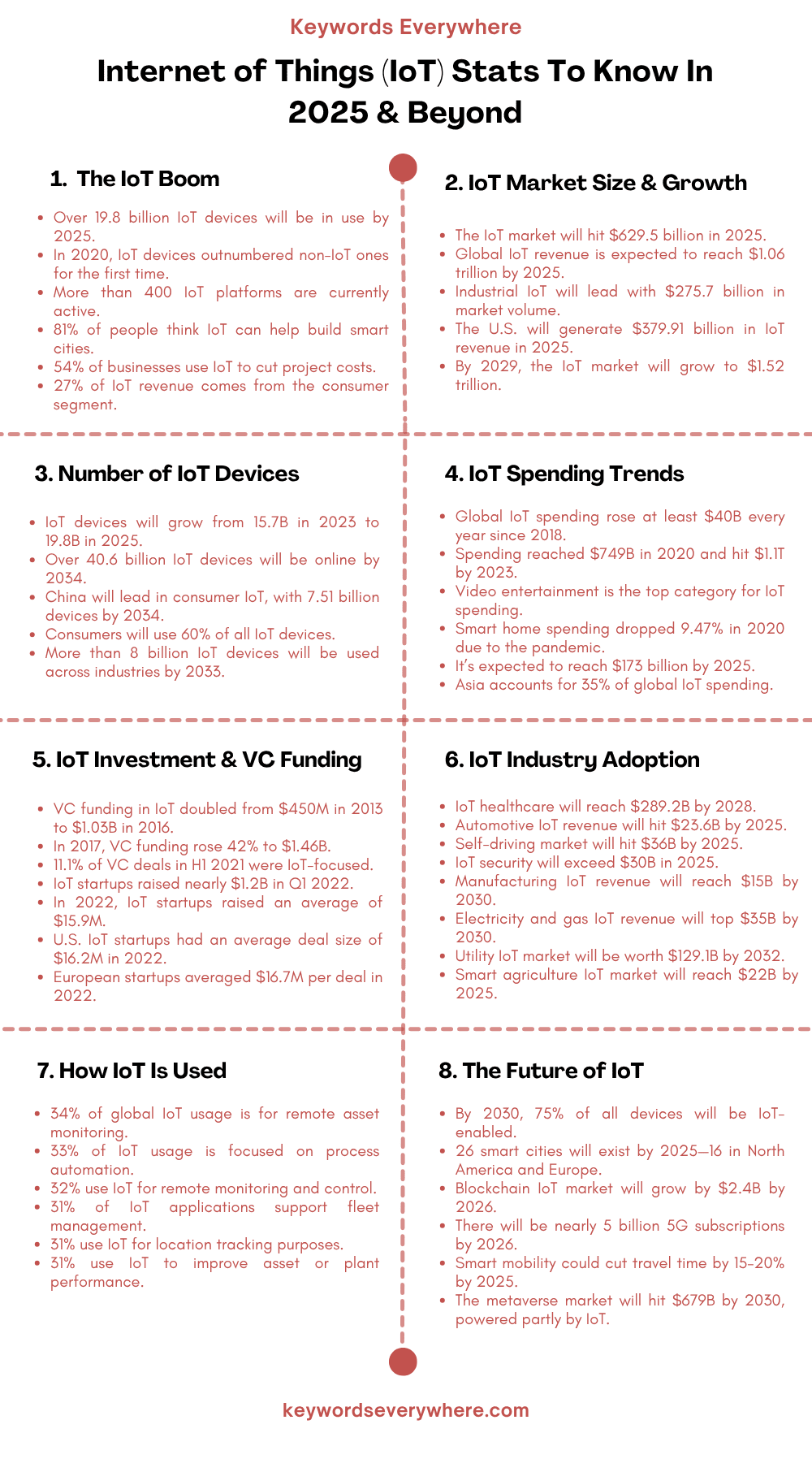
Top IoT Stats at a Glance
The Internet of Things (aka IoT) isn’t just a buzzword anymore. It has become something that we interact with every day without even realizing it.
IoT technology is now everywhere, from smart doorbells and connected devices to factory automation and smart cities.
If you want a quick overview of just how massive and important this space has become, here are our top IoT stats that show just that:
1. By 2025, there are expected to be well over 19.8 billion IoT-connected devices in use around the world.
2. In 2020, the number of IoT devices became higher than the number of non-IoT devices.
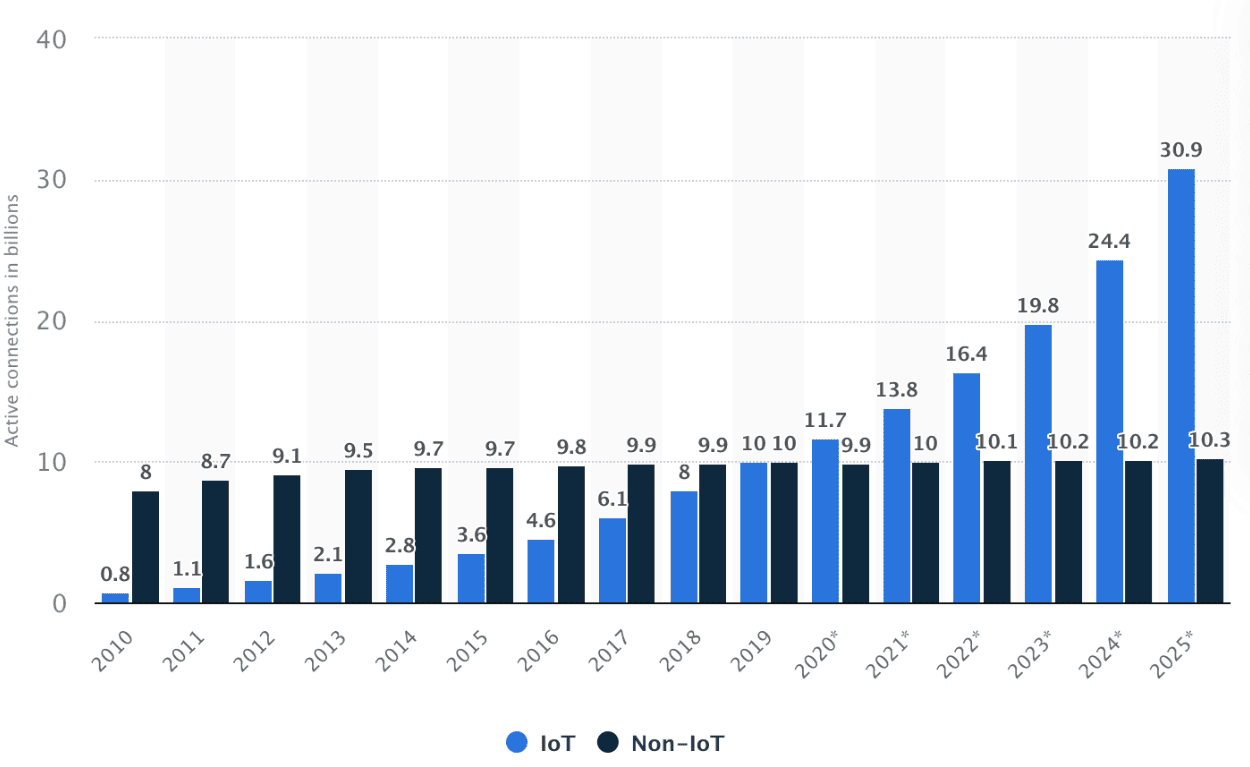
IoT vs Non-IoT devices comparison, by year
3. More than 400 IoT platforms are currently active and available.
4. The category that sees the highest spending in IoT is video entertainment.
5. By 2034, Greater China is expected to have the highest number of IoT-connected devices, with over 12 billion in use.
6. 81% of people believe that IoT technology can help create smart cities.
7. 54% of businesses use IoT to reduce the costs of their projects.
8. It’s estimated that 27% of total IoT revenue comes from the consumer segment.
9. By the end of 2025, 57% of households in the United States are expected to own smart home devices.
10. Data from Keywords Everywhere shows that many people are searching for IoT and related topics, showing rising user interest.
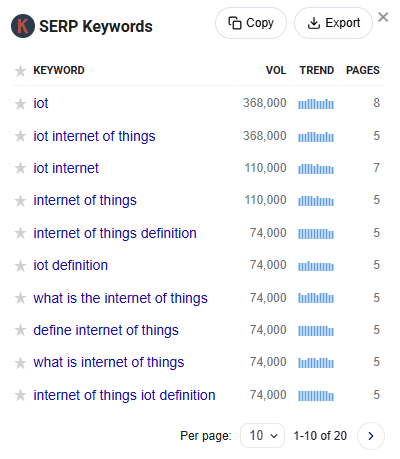
Global IoT Market Size and Growth Stats
The IoT market has gone from experimental to essential. Companies in nearly every industry are using connected technology to improve performance, reduce costs, and offer better services.
In fact, global spending on IoT is growing each year by billions of dollars, making it one of the fastest-growing areas in tech. Whether it’s industrial systems or everyday products, the impact is undeniable.
The following IoT stats reveal how fast the market is expanding.
11. The IoT market is estimated to reach a value of $629.5 billion in 2025. In comparison, it was valued at $535.97 billion in 2024.
12. The IoT market is about to grow to $1,520.12 billion by 2029, with a compound annual growth rate (CAGR) of 24.7% from 2024 to 2029.
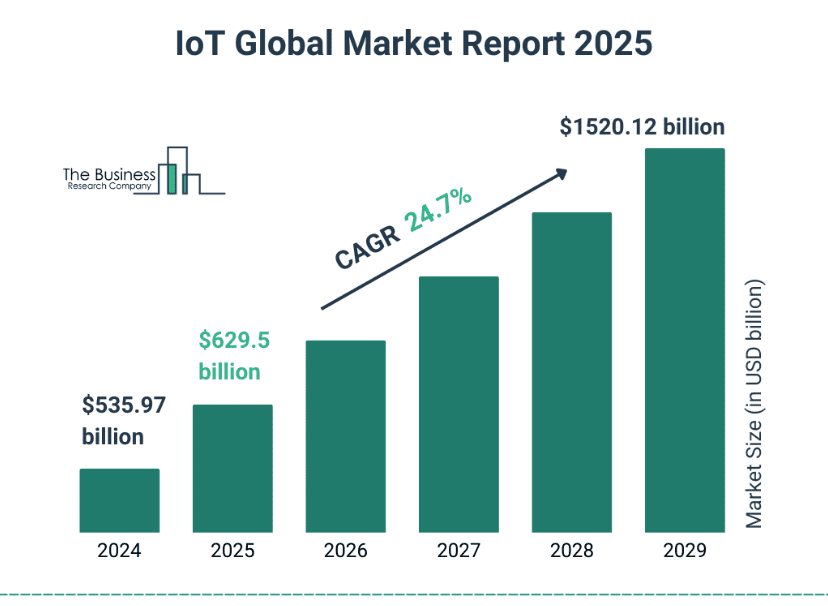
Global IoT market size
13. The global Internet of Things market is expected to see strong revenue growth, reaching US$1.06 trillion by 2025.
14. Among all IoT segments, Industrial IoT is expected to lead the market, with a market volume of US$275.70 billion in 2025.
15. When comparing regions worldwide, the United States is expected to generate the most revenue in 2025, reaching US$379.91 billion.
Number of IoT Devices Worldwide
How many connected devices do you think exist in the world right now?
The answer is much higher than most people guess, and it’s rising every year.
We’re surrounded by smart tools and gadgets that collect and share data in real time. These devices are now part of homes, businesses, vehicles, and public infrastructure.
Here are the IoT stats that show how widespread these devices are.
16. By 2025, there are expected to be about 19.8 billion devices connected through the Internet of Things (IoT), a big jump from 15.7 billion in 2023.
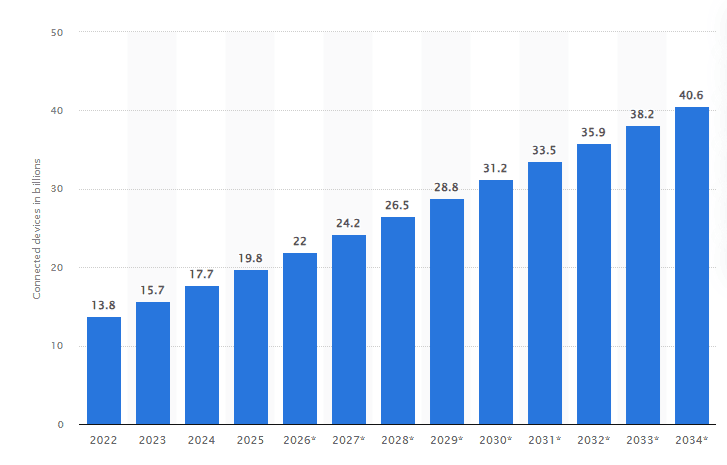
Number of IoT devices worldwide
17. The number of IoT devices around the world is set to more than double in less than a decade, reaching over 40.6 billion by 2034.
18. China is expected to lead the world in IoT devices by 2034, with around 7.51 billion consumer devices in use.
19. Most of these connected devices—about 60%—will be used by everyday consumers, not just businesses, and this share is likely to stay the same for the next ten years.
20. Several industries already have over 100 million IoT devices, including energy, water, waste management, transportation, retail, and government services. Altogether, industries are expected to use more than 8 billion IoT devices by 2033.
21. Remote asset monitoring is currently the most common use of IoT, making up 34% of global usage. Here’s a look at how different IoT use cases are being adopted around the world:
- Remote asset monitoring (read-only) – 34%
- Process automation – 33%
- Remote monitoring and control (read/write) – 32%
- Fleet management for vehicles – 31%
- Location tracking – 31%
- Improving performance of assets or plants – 31%
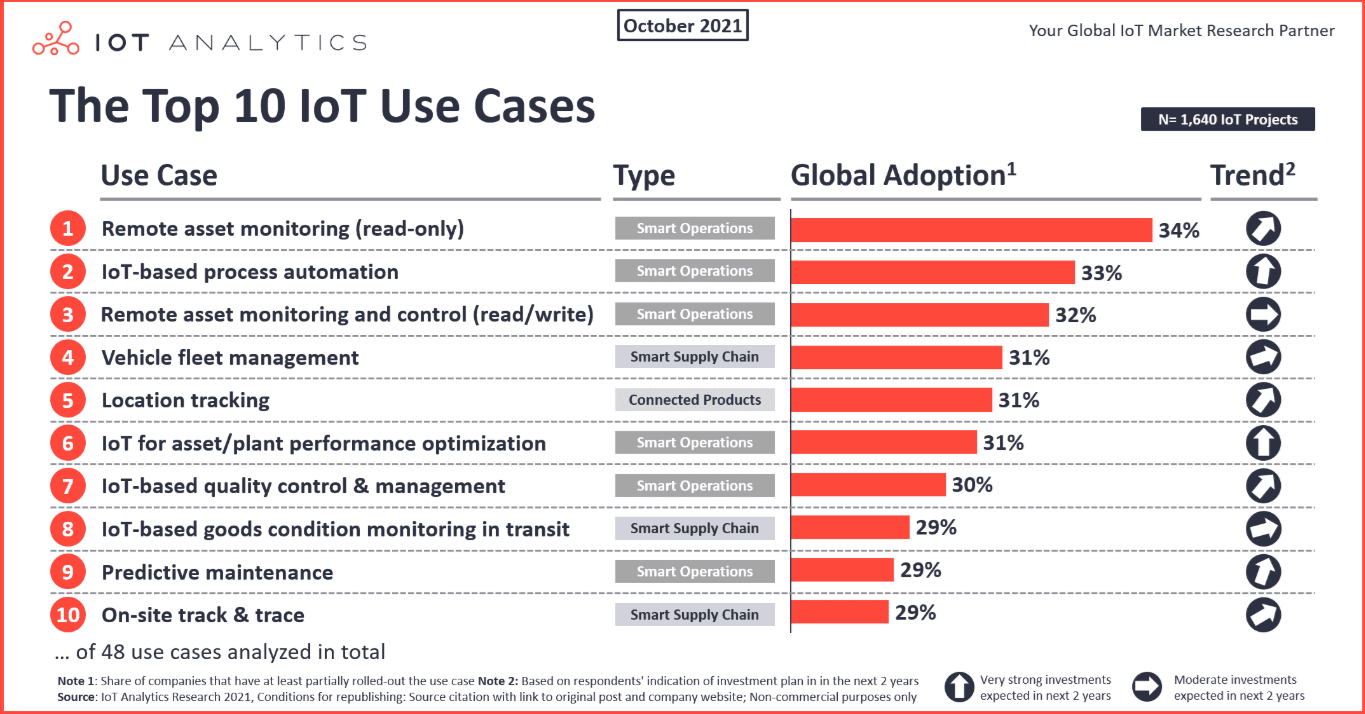
Top IoT use cases
IoT Spending Stats
As IoT adoption grows, so does the amount of money going into it.
From small businesses upgrading their systems to major corporations transforming how they operate, investments in IoT are happening on every level.
It’s not just about new gadgets either. Spending now includes software, services, infrastructure, and integration as companies get serious about connected tech.
The following IoT stats reveal where the money is going and why it matters.
22. Since 2018, worldwide IoT spending has increased by at least $40 billion every single year.
23. In 2020, total IoT spending across the globe reached $749 billion. By 2022, this number was expected to hit $1 trillion, and by 2023, it rose even further to an estimated $1.1 trillion, continuing its strong upward trend year after year.
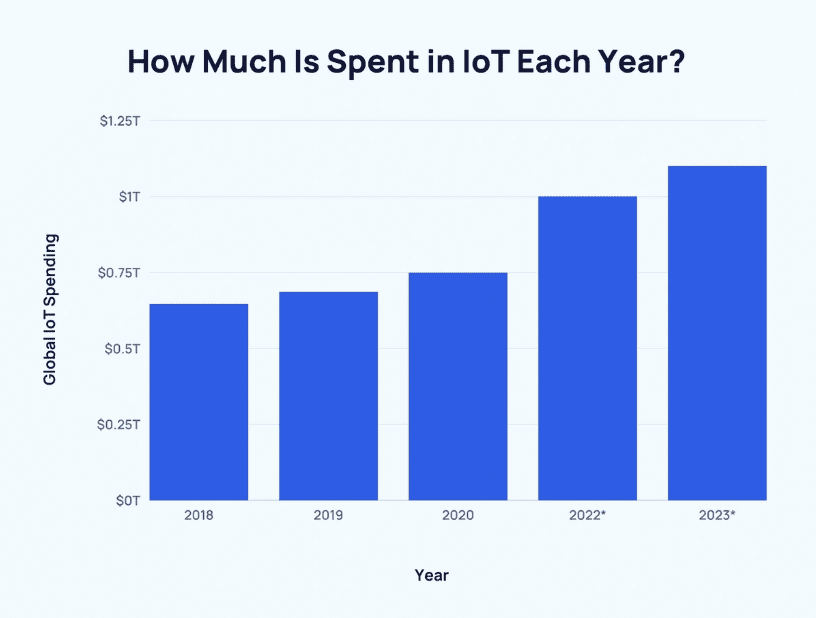
Global IoT spending
24. The video entertainment category receives more IoT-related spending than all other categories combined. It was also the largest area of smart home spending in both 2017 and 2018, proving just how popular streaming and smart TVs have become.
25. Between 2015 and 2019, consumer spending on smart home devices increased by at least 12% each year.
26. Unsurprisingly in 2020, during the height of the pandemic, smart home consumer spending dropped by 9.47%. However, spending is expected to bounce back and keep rising through 2025, eventually reaching a projected figure of $173 billion.
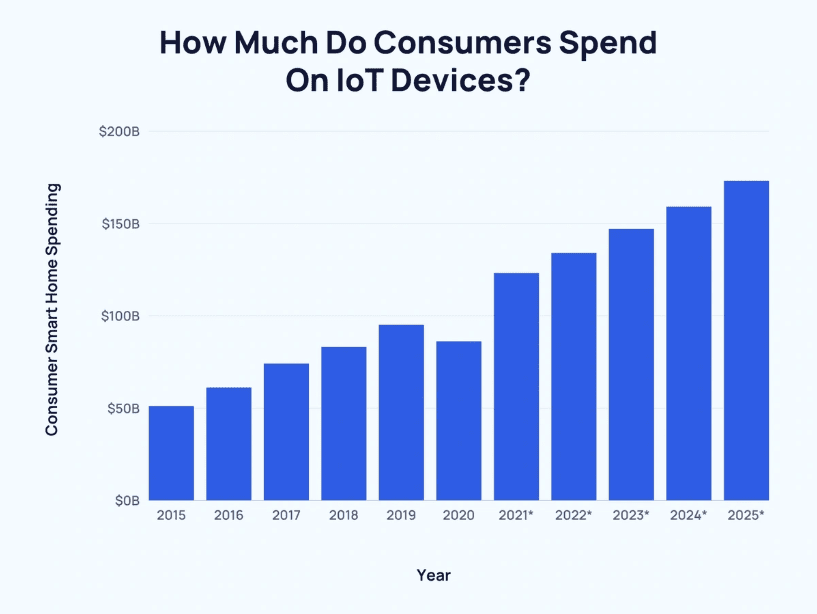
Consumer smart home spending
27. As of 2023, Asia accounts for 35% of all IoT spending worldwide, making it the largest regional market. That means more than one-third of global IoT investment comes from Asia, followed by North America, Europe, the Middle East, and Africa.
Venture Capital and IoT Investment Stats
Some of the biggest shifts in IoT are being driven by startups with fresh ideas and bold solutions. Behind many of those startups are venture capital firms that see major potential in connected technology.
Investment is flowing into areas like smart healthcare, energy management, logistics, and more, with billions being raised for IoT-focused innovation.
Here are the IoT stats that show where investors are placing their bets.
28. Between 2013 and 2016, venture capital (VC) funding in the IoT space more than doubled, rising from around $450 million to $1.03 billion. During the same time, the number of VC deals also grew from about 170 to 340.
29. In 2017, VC funding in IoT jumped again—up 42% to $1.46 billion—even though the number of deals dropped to under 300, meaning each deal was, on average, much larger than before.
30. In the first half of 2021, 11.1% of all VC deals were made in the IoT sector.
31. At the start of 2022, IoT VC investments hit nearly $1.2 billion, a huge jump from the $266 million recorded in Q1 of 2021.
32. Even though total VC funding in the IoT sector dropped by 22% in 2022, and the broader VC market fell by 35%, the average amount raised by IoT startups reached the highest level in over 10 years.

Average funding round for IoT startups
33. In 2022, IoT companies raised an average of $15.9 million, which was 30% higher than the previous year, according to research by Avnet Abacus.
34. U.S.-based IoT startups saw an average deal size of $16.2 million in 2022—the highest in 19 years—matching the overall global trend of larger investments in fewer companies.
35. European IoT startups had their highest average funding round ever in 2022, with an impressive $16.7 million per deal.
36. The Industrial IoT sector also hit a major milestone in 2022. The average deal size reached $16.1 million, more than double the $7.3 million average in 2021, and the highest since 2006, when only one deal was recorded that year.
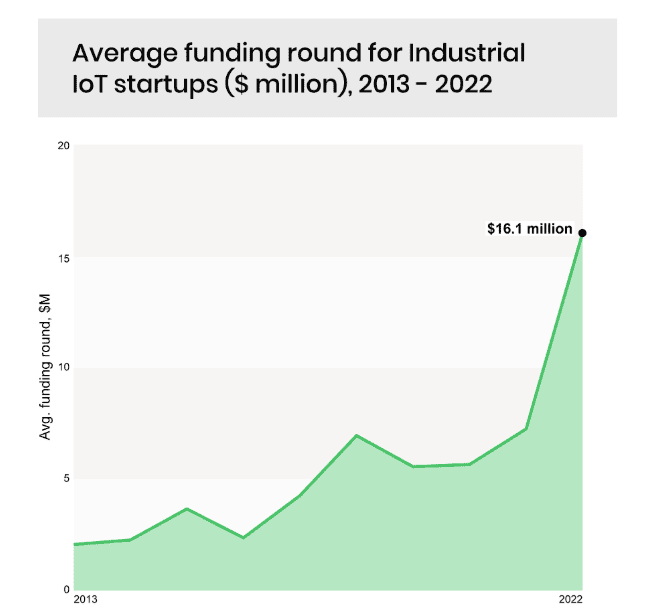
Average funding round for Industrial IoT startups
IoT in Various Industries
IoT technology doesn’t look the same everywhere. For example:
- In healthcare, it helps monitor patients remotely.
- In agriculture, it supports smarter crop management.
- In manufacturing, it keeps production lines running efficiently.
This flexibility is one reason why IoT is spreading so fast. Every industry is finding different ways to use it to solve problems and improve their performance.
The following IoT stats reveal how different industries are using smart tech to work smarter.
37. The IoT healthcare market is expected to reach a value of $289.2 billion by 2028. North America currently leads the sector, holding the largest revenue share at 37%.
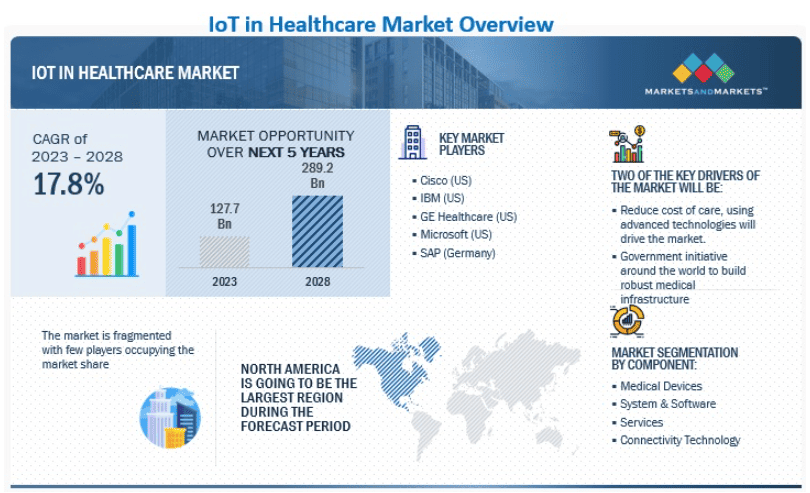
IoT in healthcare market overview
38. In 2022, there were around 6 million active healthcare IoT devices in the European Union. That number will double to nearly 12 million by 2026, showing rapid growth in connected healthcare technologies.
39. Among healthcare organizations using IoT, over 70% rely on these devices for monitoring and maintenance. 50% use IoT for remote operation and control, and 47% connect their devices to location-based services for tracking and coordination.
40. The automotive IoT industry is projected to generate around $23.6 billion in revenue by the end of 2025, as more vehicles become connected and smarter on the road.
41. The self-driving vehicle market is forecasted to reach a value of $36 billion by 2025. In terms of regional market share, North America will lead with 29%, followed by China at 24% and Western Europe at 20%.
42. The IoT security market is expected to surpass $30 billion in value by 2025, as more connected devices bring growing concerns about digital threats. The top security issues are malware (49%), human error (39%), and DDoS attacks (22%).
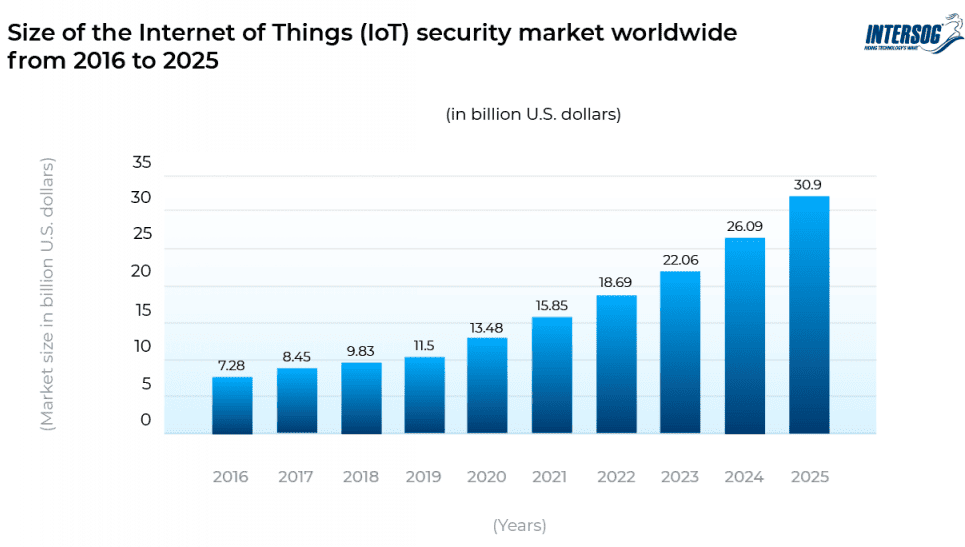
Size of IoT security market worldwide 2025
43. In 2022, the global manufacturing sector generated $5.5 billion in IoT revenue. That number is expected to grow to $11.2 billion by 2027, and then reach $15 billion by 2030.
44. Around 58% of manufacturers report that IoT is essential for digital transformation and helps improve their operational efficiency through automation and real-time data.
45. In the electricity and gas sector, IoT revenue was recorded at $18 billion in 2022 and is projected to climb past $35 billion by 2030, reflecting a major shift toward smart utility management.
46. The overall utility IoT market is expected to be worth $129.1 billion by the end of 2032, with a projected compound annual growth rate of 11.9% year over year.
47. By 2025, IoT technologies are expected to save nearly $500 billion in the global power sector, thanks to improved efficiency, better resource management, and predictive maintenance.
48. Commercial drones are now a key part of industrial IoT. More than 40% of commercial drones are used for industrial inspections, especially when equipped with non-destructive testing to check structures without causing damage.
49. The IoT-based smart agriculture market will hit $22 billion by 2025, with farmers increasingly using RFID, GPS, sensors, and drones to automate tasks, collect data, and improve crop yields.
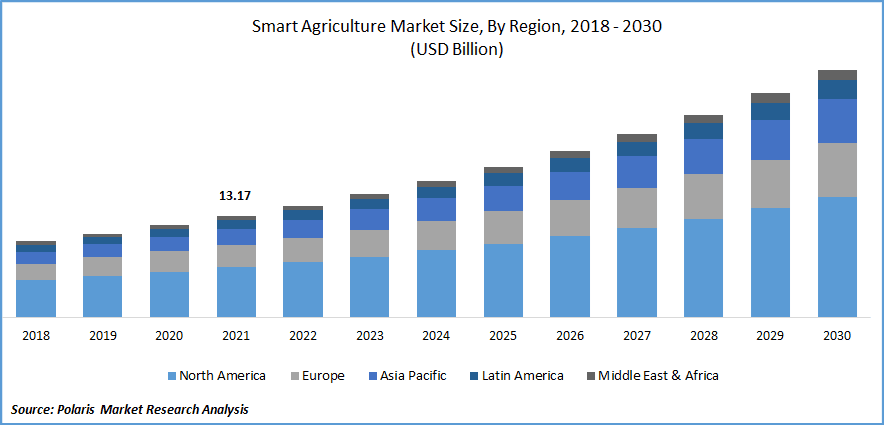
Smart agriculture market size by region
50. The IoT sector in the automotive industry is on track to reach $23.6 billion in revenue by 2025.
The Future of IoT: What to Expect
The next wave of IoT is already taking shape. With technologies like artificial intelligence and 5G becoming more common, connected devices are about to get even smarter and faster.
But what exactly should we expect in the years ahead?
Here are the IoT stats that show where things are headed next.
51. The biggest security concern in IoT is attacks on devices that could affect critical operations, according to a survey where 33% of respondents cited it as their top issue.
52. Other major concerns in the same survey include a lack of skilled personnel to implement IoT security (32%), protecting sensitive data from IoT devices (31%), identifying sensitive data (27%), and the loss or theft of IoT devices (27%).
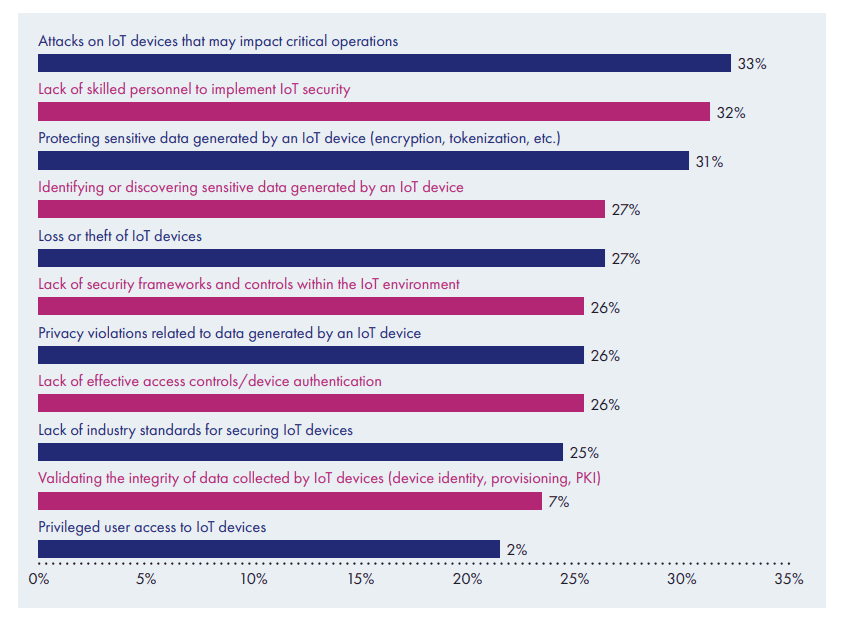
IoT security concerns
53. A 2019 survey revealed that the biggest opportunity in IoT is smart cities, with 81% of respondents saying IoT could improve areas like traffic management, digital signage, waste management, and more.
54. By the end of 2025, there will be around 26 smart cities globally. Of these, 16 will be located in North America and Europe, while the remaining cities will be in the Asia-Pacific region.
55. As more devices become connected, the tech world is shifting rapidly. By 2030, it’s expected that 75% of all devices will be IoT-enabled.
56. According to data from Markets and Markets, the global blockchain IoT market will grow by USD 2,409 million by 2026, as more industries combine secure blockchain networks with IoT capabilities.
57. By 2026, there will be nearly five billion 5G subscriptions worldwide. This growth in 5G is key, as 5G networks are essential for unlocking the full power and speed of IoT technologies.
58. McKinsey reports that cities using smart mobility technologies could reduce average travel times by 15 to 20% by 2025, by improving traffic flow, navigation, and transport systems.
59. Voice-activated IoT devices are becoming more common. According to Think with Google, 27% of people around the world use voice search on their mobile phones daily.

Voice search use by device
60. The global metaverse market is forecasted to hit $679 billion by 2030, according to Grandview Research. IoT plays a key role in the metaverse as it helps connect digital and physical experiences through real-time data and smart devices.
Conclusion
That brings us to the end of our IoT stats.
From major investments and rising security challenges to breakthroughs in healthcare, smart cities, and industrial automation, these stats show just how fast IoT is shaping the future.
As more devices come online and technologies like 5G and blockchain unlock new capabilities, IoT is becoming the backbone of innovation across nearly every industry.
With billions of connected devices expected in the next few years, the impact of IoT will only continue to grow, changing the way we live, work, and interact with the world around us.


